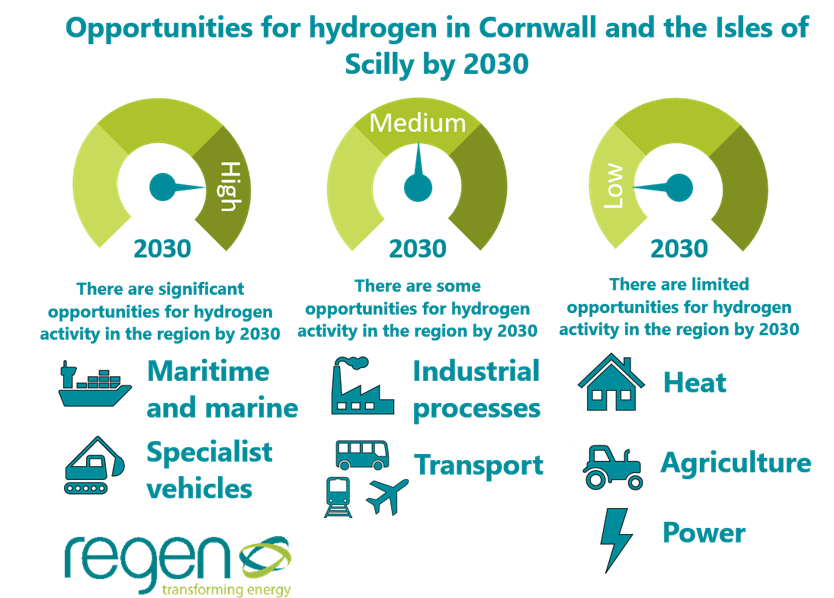 Grace Millman reflects on Regen’s work with Cornwall Council and the Cornwall and Isles of Scilly LEP to identify the potential opportunities for hydrogen to support decarbonisation in the region by 2030.
Grace Millman reflects on Regen’s work with Cornwall Council and the Cornwall and Isles of Scilly LEP to identify the potential opportunities for hydrogen to support decarbonisation in the region by 2030.
Regen recently conducted a short hydrogen opportunity study for Cornwall Council and the Cornwall and Isles of Scilly LEP focusing on the period to 2030. The study sought to identify the potential for hydrogen, both as a low carbon fuel and as a driver for innovation and economic growth in the region. This study explored many elements of the hydrogen discussion: scale, use cases and regionality. You can read the executive summary here.
Hydrogen has historically been used as a fuel in many industries, such as oil refining, ammonia production and steel manufacturing. In the UK, 27 TWh[i] of hydrogen is produced annually, however most of this is produced using unabated fossil fuels, resulting in significant carbon emissions of c. 7.5 MtCO2[ii]. Other forms of hydrogen production, such as green hydrogen produced from the electrolysis of water, and blue hydrogen, which involves combining methane reformation with carbon capture and storage (CCS), produce notably less carbon emissions.
With net zero emissions targets now enshrined in UK law[iii], carbon-intensive “difficult to decarbonise” sectors have been identified as key source of emissions that need an effective and lasting solution. With electrification considered to be a challenging or less viable option for many of these sources of demand, such as heavy-duty vehicles, long haul aviation, and high-temperature industrial processes, due to inefficiencies or cost, another solution is desperately needed to tackle these hard to decarbonise sectors. Low carbon hydrogen has been considered a possible option and future fuel for these sectors, dividing opinions across the energy sector and beyond, and leaving many unsure as to the realistic role of hydrogen in a net zero future.
Undertaking a regional opportunity assessment in Cornwall enabled us to explore some of the regional variations that are likely to influence the uptake of low carbon hydrogen. The unique characteristics of Cornwall as a county and local authority region also resulted in some interesting conclusions for a variety of potential use cases and sectors.
Opportunities for hydrogen in Cornwall and the Isles of Scilly were identified by considering the region’s:
- unique geography – notably its extensive coastline and maritime industry, as well as numerous quarries
- natural resources – including any potential hydrogen storage and the region’s renewable energy and water resources
- strategic and decarbonisation priorities – Cornwall Council have pledged to reach net zero emissions by 2030
- existing hydrogen and non-hydrogen activity
- key and regional stakeholders in the form of engagement interviews
As part of the process, key organisations were contacted to gauge views around the opportunity for hydrogen in general and for specific uses/sectors. Most stakeholders that we engaged had a good knowledge of hydrogen and its potential role in reaching net zero emissions and were positive about the potential for green hydrogen in Cornwall and the Isles of Scilly. Blue hydrogen was considered a less suitable production option for Cornwall and the Isles of Scilly, due to reduced gas network coverage and lack of suitable CCS infrastructure. It could also be detrimental to Cornwall Council’s 2030 net zero target, as adequate CCS technology is unlikely to be commercially available before 2030. The region is well suited to the production of green hydrogen, owing to its abundant renewable energy resources, and could see the deployment of some small-scale, decentralised electrolysers by 2030.
After assessing the suitability of Cornwall and the Isles of Scilly for hydrogen production, the project considered the potential demand for hydrogen in the county from a variety of potential end use sectors. Major developments in hydrogen production are likely to be focused around industrial clusters, for example the Humber region and Teesside, so it is unlikely that Cornwall and the Isles of Scilly will see the deployment of significant or a strategic centralised hydrogen production hub, however there are many sectors which could potentially be decarbonised through the use locally produced green hydrogen or hydrogen imported in the form of ammonia. Some specific sectors that showed strong potential, include the maritime and marine industries in Cornwall and the Isles of Scilly, which have more than doubled in size over the last 14 years and are responsible for 12,500 jobs in Cornwall[iv], and Cornwall’s mining and aggregate industries, where heavy duty, specialist vehicles are difficult to decarbonise and challenging to electrify. There are also potentially significant hydrogen research and development opportunities for Cornwall and the Isles of Scilly in the aviation, maritime, and agriculture sectors.
In comparison, the report found that hydrogen would have limited potential for heating in Cornwall and the Isles of Scilly by 2030, as large areas of Cornwall are off-gas and the likelihood of Cornwall converting to a hydrogen gas network before 2030 is low. Cornwall Council has already made a commitment to no longer provide natural gas as a source of energy in new build homes, and instead are supporting the use of greener alternatives.

The report concluded with a number of recommendations. One of these was to consider establishing a Cornwall Hydrogen Working Group, to explore some of the high level opportunity areas and other considerations highlighted in more detail.
By assessing the regional and sector-specific opportunities for hydrogen in the unique context of Cornwall and the Isles of Scilly, we were able to provide the Council and the LEP with a realistic set of recommendations on how to consider hydrogen as a driver for innovation and economic growth in the region, supporting their ambition to be carbon neutral by 2030.
The use of hydrogen must be strategic and focus on areas where it provides the optimal pathway for decarbonisation, and through conducting detailed assessments of Cornwall’s unique characteristics, we were able to realistically assess the scope and scale of future hydrogen demand in Cornwall and the Isles of Scilly. This will inform our policy asks ahead of the Hydrogen Strategy, to ensure that a future hydrogen scenario is realistic in its scale and clear about where hydrogen adds the most value over other decarbonisation options.
For more information about Regen’s work on hydrogen, please visit our hydrogen insight website, where you’ll be able to access our insight papers, articles and podcasts, that show Regen’s views on the the development and challenges of the low carbon hydrogen sector and the role it could potentially play in achieving net zero.
[i] Committee on Climate Change, Hydrogen in a low-carbon economy, 2018
[ii] Forbes, Estimating the carbon footprint of hydrogen production, June 2020
[iii] The Climate Change Act 2008 (2050 Target Amendment), 2019
[iv] https://cornwallmarine.net/statistics
